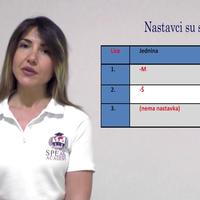Lesson 3.2 Part II Serbian Language - How to Build PRESENT
Урок|Часть||Сербский|Язык|Как|(частица действия)|Построить|Настоящее время
|||||how||Build|present
|||||Як||Будувати|теперішній час
Lektion 3.2 Teil II Serbische Sprache – Wie man PRESENT aufbaut
Μάθημα 3.2 Μέρος II Σερβική Γλώσσα - Πώς να δημιουργήσετε το ΠΑΡΟΝ
Lesson 3.2 Part II Serbian Language - How to Build PRESENT
Lección 3.2 Parte II Idioma serbio: cómo construir PRESENTE
Leçon 3.2 Partie II Langue serbe - Comment construire le PRÉSENT
Lezione 3.2 Parte II Lingua serba - Come costruire PRESENT
Lekcja 3.2 Część II Język serbski – Jak budować teraźniejszość
Ders 3.2 Kısım II Sırp Dili - PRESENT Nasıl Oluşturulur
课 3.2 第二部分 塞尔维亚语 - 如何构建现在时
Урок 3.2 Часть II Сербский язык - Как построить ПРЕЗЕНТ
PREZENT
ПРЕЗЕНТ
Présent
present
подарунок
ПРЕЗЕНТ
Sad je vreme da naučimo kako se gradi prezent.
Теперь|есть|время|чтобы|мы научимся|как|себя|строится|настоящее время
Now||time||learn|||builds|present tense
Сумно||||вивчимо як|||будується презент|
Jetzt ist es an der Zeit zu lernen, wie man ein Geschenk bastelt.
Now is the time to learn how the present tense is formed.
Теперь пришло время научиться, как строится презент.
U srpskom jeziku prezent se gradi od prezentske osnove i nastavaka (prezentska osnova + nastavci).
В|сербском|языке|настоящее время|(частица)|образуется|от|настоящей|основы|и|окончаний|(настоящая|основа|окончания)
||||||||base verbale||terminaisons|||
|||||||present tense|base||endings|present|base|endings (1)
|||||||теперішній|основа||закінчень|презентна|основа|закінчення дієслів
||||||||grundlag|||||
In the Serbian language, the present tense is formed from the present stem and endings (present stem + endings).
В сербском языке презент строится от презентной основы и окончаний (презентная основа + окончания).
Prezentsku osnovu dobijamo tako što od prvog lica množine prezenta odbijemo nastavak –mo, recimo ako imamo glagol trčati:
Презентскую|основу|получаем|так|что|от|первого|лица|множественного|презента|отнимаем|окончание|–мо|скажем|если|имеем|глагол|бегать
|base du présent|obtenons|||||personne||||terminaison||||||
present|basis|we get|"by"|||first|first person plural|plural|present|we remove|ending|we|for example|if|we have|verb|"to run"
Презентну|основу|отримуємо|||||||презент|відкидаємо||мої|наприклад||||бігти
||||||||flertallet|præsentum||||||||
The present stem is obtained by removing the ending -mo from the first person plural of the present tense, for example, if we have the verb to run:
Презентную основу мы получаем, отнимая окончание –мо от первого лица множественного числа презента, например, если у нас есть глагол бегать:
Mi trčimo
Мы|бегаем
|we run
|бігаємо
We are running
Мы бегаем
Mi trčimo
Мы|бегаем
|run
We are running
Мы бегаем
Osnova je trči-.
основа|есть|бежать
La base||
||run
||бігти
The basis is run-.
Основа - бегать.
Njoj dodajemo nastavke.
Ей|добавляем|окончания
À elle|Nous ajoutons|extensions
To it|we add|suffixes
їй|додаємо|додатки
We are adding sequels to it.
К ней добавляем окончания.
Nastavci su sledeći:
Продолжения|есть|следующие
||suivants
The suffixes||next
||наступні
The sequels are as follows:
Окончания следующие:
Oni pričaju.
Они|говорят
|speak
|говорять
They are talking.
Они говорят.
Oni vuku.
Они|тянут
|pull
|тягнуть
de|
They pull.
Они тянут.
Oni trče.
Они|бегут
|are running
|вони бігають
They are running.
Они бегут.
Kada se koji od ova tri nastavka upotrebljava, govorićemo u nekoj od narednih lekcija.
Когда|(возв)|который|из|этих|трех|окончаний|употребляется|мы будем говорить|в|какой-то|из|следующих|уроков
Quand||lequel||||suffix|utilise|||||prochaines|
||which||||suffix|is used|we will talk||one of||upcoming|lessons
||||||продовження|використовується|говоритимемо||якійсь||наступних|
When each of these three suffixes is used, we will discuss it in one of the upcoming lessons.
Когда используется одно из этих трех окончаний, мы поговорим в одном из следующих уроков.
Glagol zvati se u prezentu (potvrdni oblik)
Глагол|звать|себя|в|настоящем времени|утвердительный|форма
Verbe s'appeler présent|s'appeler||||affirmatif|forme affirmative
|to call||||affirmative|
|||||підтверджувальний|
The verb 'to be called' in the present (affirmative form)
Глагол называться в настоящем времени (утвердительная форма)
Glagol imati (prezent, potvrdni oblik)
Глагол|иметь|настоящее время|утвердительный|форма
|||affirmative|form
The verb to have (present, affirmative form)
Глагол иметь (настоящее время, утвердительная форма)
Da bismo dobili odrični oblik glagola, dodaćemo ispred rečcu ne. Rečca ne piše se odvojeno od glagola.
Чтобы|мы|получили|отрицательный|форма|глагола|мы добавим|перед|частицей|не|Частица|не|пишется|(возв)|отдельно|от|глагола
||obtenu|négatif|||||particule ne||||||séparément||
|we|get|negative|||we will add|in front of|particle||particle||||separately||
||отримали||||додамо||частка не||||||окремо||
|||negativt|||||||||||||
To get the negative form of the verb, we will add the word 'not' in front of it. The word 'not' is written separately from the verb.
Чтобы получить отрицательную форму глагола, мы добавим перед ним частицу не. Частица не пишется отдельно от глагола.
Ja se ne zovem Marija. Ja se zovem Aleksandra.
Я|себя|не|зову|Мария|Я|себя|зову|Александра
||||Maria||||
||||Марія||||
My name is not Marija. My name is Aleksandra.
Меня не зовут Мария. Меня зовут Александра.
Ali, kod glagola imati, rečca ne piše se spojeno sa glagolom.
Но|у|глагола|иметь|частица|не|пишется|себя|слитно|с|глаголом
||||particule ne||||attaché||
|about|verb||||||||verb
|з контекстом|||||||||дієсловом
||||||||sammen||verbet
But, with the verb to have, the word is not written in conjunction with the verb.
Но, у глагола иметь, частица не пишется слитно с глаголом.
SENT_CWT:AFkKFwvL=3.63 PAR_TRANS:gpt-4o-mini=1.99
ru:AFkKFwvL
openai.2025-01-22
ai_request(all=23 err=0.00%) translation(all=19 err=0.00%) cwt(all=133 err=1.50%)

